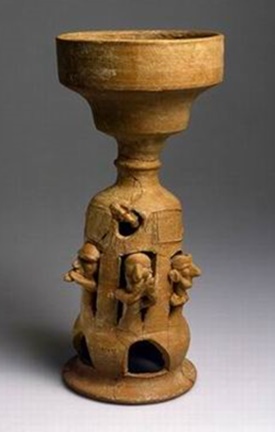Print Article
Author's Bias | Interpretation: conservative | Inclination: dispensational | Seminary: none

© Israel Museum of Jerusalem
Once occupied by the Anakim (Josh 11:22), Ashdod was taken
over by the Philistines (Josh 13:3) and later became the religious
center for the Philistine god Dagon (1 Sam 5:1-7). Philistia,
the land comprised of the Philistine Pentapolis, encompassed the cities: Ashkelon, Ashdod, Ekron, Gath and Gaza.
Some 3,000 years later, while excavating Tell Mor in Ashdod during the 1960s, Israeli
archaeologist Moshe Dothan recovered a Philistine cult stand featuring five musicians.
Specializing in Maritime Civilizations, Dothan found Ashdod to have 22 layers of debris which
indicated that it was occupied continuously from the 17th century B.C. through the 15th century A.D.
Stands holding libations or incense for religious offerings were called cult stands and were fairly common
in the Near East. Made of stone, bronze or clay, most cult stands made by pagan cultures during the Conquest
and the establishment of the united Kingdom of Israel were of clay.
The Ashdod cult stand with five musicians was dated to the 10th century and reflected Philistine art and
culture. The construction and decoration were typical of Philistine ceramics.
The cylindrical clay stand stood 34.7 cm (13.7 in) high, and its base was 14.2 cm (5.6 in)
wide.
Displayed through four windows cut around the base, four musicians are playing instruments:
one plays a frame drum, one plays a stringed instrument (i.e. lyre), one plays a two piped instrument (i.e. a
double flute) and one plays a cymbal.
The fifth player, largest of them all, plays a double flute and appears to be protruding out
of his window; he may represent the leader of the group.
Inscribed above the musicians are 3 rectangles each containing a crudely inscribed animal,
which scholars believe may represent a procession of animals going to sacrifice.
With its portrayal of five musicians, the Philistine cult stand is significant for providing a better
understanding of the biblical text regarding instruments. Of particular note is that the Ashdod 5-musician cult
stand dating corresponds to the approximate time when the Bible specifically refers to musician – prophets in
the vicinity of Philistines:
Afterward you will come to the hill of God where the Philistine garrison is; and it
shall be as soon as you have come there to the city, that you will meet a group of prophets coming down from the
high place with harp, tambourine (frame drum), flute (double flute), and a lyre before them, and
they will be prophesying. (1 Sam 10:5)
References:
1. Fant CE and Reddish MG, Lost Treasures of the Bible, Grand Rapids: Eeardmans Publishing (2008).
2. Hestrin R, The Philistines and the Other Sea Peoples, Jerusalem: The Israel Museum (1970).
3. From the website: Society of Old Testament Study (SOTS) project, Jerusalem Fall of a City – Rise of a Vision: "Musicians Cult Stand from Ashdod."
Copyright ©
2018
Helpmewithbiblestudy.org. All rights to this material are reserved. We encourage you to print the material for personal and
non-profit use or link to this site. If you find this article to be a blessing, please share the link so that it may rise in
search engine rankings.